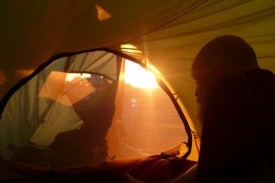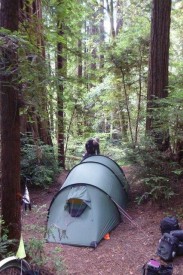We have recently described our frustrations with the zippers on our Hilleberg failing in this blog post. There are plenty of features we do like about the Hilleberg, however, and if they could only get the zippers problem sorted, we think it would be the perfect tent.
Fabric strength: It has taken some serious beating. We have heard of people losing or ripping tents while pitching theirs in Patagonia. We pitched in very strong winds which we could barely walk in and even in the middle of the night on Tierra del Fuego, and the fabric withstood such battering admirably.

Rigidity: We endured a massive thunderstorm with winds from all directions which shook the tent and bent the poles down so they touched us laying inside, for more than 12 hours on New Years Eve, 2012. Other campers bailed out and hid in their cars or the refuge shelter, while we woke up dry albeit in a ‘waterbed’ with 10cm of the wet stuff all around and underneath us.
 UV resistance: Camping for more than a year in summer temperatures and in strong UV light in New Zealand, Australia, Argentina, Chile and the USA has caused the fabric to fade, which is to be expected. We’ve also spotted two 3mm diameter holes in the fly, probably caused by an insect of some kind. But neither has apparently weakened the fabric.
UV resistance: Camping for more than a year in summer temperatures and in strong UV light in New Zealand, Australia, Argentina, Chile and the USA has caused the fabric to fade, which is to be expected. We’ve also spotted two 3mm diameter holes in the fly, probably caused by an insect of some kind. But neither has apparently weakened the fabric.
Temperature regulating: Even when the sun was beating down we were some of the few campers who could hide and stay cool in our tent because of its great venting arrangements. It is surprising warm too. Zip everything up and crawl into our down sleeping bags and we are as snug as a frog in a sock. Many times we have had to open up the tent during freezing nights because it is so well insulated.
Quick-drying: After rainy nights we’ve often had to pack the tent up dripping wet. But, pitch it again later that day and we only have to leave the doors and vents open for a short time before the inner is bone dry again. Because of this, we haven’t bothered to do what many other campers do, taking the inner down and pack it in a dry sack to try to keep the inner dry. Taking the inner down and putting it up again takes the same time as it would to dry out. Wiping the fly with a cloth to get the worst of the water/dew off helped speed the drying time up and even with a much bigger tent than others, ours dried faster.
Durability of groundsheets: We have pitched on ground that other have failed to manage and the footprint groundsheet has taken some serious beating. Bar a few holes it is still going strong and there are no holes in the sewn-in interior groundsheet.
 Capacity: It is probably the only tent that can fit me inside (I’m 6’4″/194cm) where I don’t touch the walls, which has been a big problem with many other tents I’ve tried. I’ve woken up many times with a very wet sleeping bag because I’m too tall for most tents. In the Kaitum 3GT we have plenty of room to move around and not knee each other, which is rather important when you are living in such small space for so long as we did. (Another reason why we didn’t go for the heavier Keron 3GT is that it is not as wide inside.)
Capacity: It is probably the only tent that can fit me inside (I’m 6’4″/194cm) where I don’t touch the walls, which has been a big problem with many other tents I’ve tried. I’ve woken up many times with a very wet sleeping bag because I’m too tall for most tents. In the Kaitum 3GT we have plenty of room to move around and not knee each other, which is rather important when you are living in such small space for so long as we did. (Another reason why we didn’t go for the heavier Keron 3GT is that it is not as wide inside.)
Pole strength: The poles when the tent was pitched flexed very well under immense pressure from strong winds in Patagonia. I did manage to break a pole when pushing it through a pole sleeve while not paying attention, but this was very easily fixed with the spare pole section that came with the tent.
You can also read our original review of the Hilleberg Kaitum 3GT. And you can read our review of the zipper failure here. Hilleberg have responded to our email and have offered to change our zippers, so we will update the blog once that has happened.

So did hilleberg ever fix the zipper
Hi Charles, yes they did see here – https://woollypigs.com/2013/05/review-when-hilleberg-zippers-fail-and-fail-again/